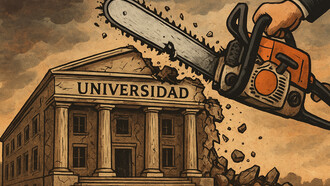I.
In the midst of the predominantly peaceful national and global protests that followed the asphyxiation of George Floyd by a Minneapolis police officer, President Trump outrageously proclaimed that he was an “ally of all peaceful protesters.”
This claim was made at roughly the same time that Federal forces, mounted on horseback, brutally cleared Lafayette Park in Washington D.C. of peaceful protesters— so that Trump could wave the Holy Book in a photo-op outside the historic St John's Church on June 1, 2020—in a self-righteous display of idolatry.
The solipsist President (some 80% of Americans describe Trump as “self-centered” while 59% view him as “prejudiced”) wanted to portray himself as the one and only Savior who can protect the already heavily armed American population against any presumed domestic or international threats.
After a heated debate with Trump (denied, of course, by the White House), the Secretary of Defense, the Chairman of the Joint Chiefs of Staff, and major figures in the Republican Party, were able to block Trump’s desire to “dominate the streets” with at least 10,000 active US military troops. As Trump threatened force, his ratings began to drop in the polls—while divisions among Republicans appear to have deepened between pro-Trumpists and generally neo-conservative Never Trumpers.
Nevertheless, after checking out the conditions of his nuclear bunker, President Trump—the man who cannot figure out whether he is an isolationist Plutocrat or a neo-conservative Timocrat—is still waiting for the right moment to crack down on protests after reviving Richard Nixon’s slogan as the president of “Law and Order.”
As I argued in World War Trump, Trump does not seek to reconcile, but to polarize. Trump’s game is to create exaggerated fears of both domestic and external “bogeymen” so as to rally the American people behind him. He wants to galvanize Americans in his struggle against China, Iran, Moslems, illegal immigrants, “Fake News” journalists, looters, and other “bad people”— in the hope that domestic and international polarization will help him clinch the US Presidency in November 2020.
In response to the massive protests against police brutality, Trump has wanted to use Executive Order 13224 to label the amorphous, not-so-well organized, “anti-fascist” group, Antifa, as a “terrorist organization”—a group that had grown to prominence due to their militant opposition to the August 2017 “Unite the Right” rally of white supremacists in Charlottesville.
US Attorney General William Barr has claimed that Antifa and other alleged criminal groups have been preventing “constructive engagement between affected communities and law enforcement leaders – to address legitimate grievances… To identify criminal organizers and instigators, and to coordinate federal resources with our state and local partners, federal law enforcement is using our existing network of 56 regional FBI Joint Terrorism Task Forces (JTTF).”
Trump has accordingly criticized Liberal Democrats for their failure to crack down on the “anarchist-” and “terrorist-” backed “Capitol Hill Autonomous Zone” in Seattle, Washington. As Trump himself put it: “Seattle Mayor says, about the anarchists takeover of her city, “it is a Summer of Love”. These Liberal Dems don’t have a clue. The terrorists burn and pillage our cities, and they think it is just wonderful, even the death. Must end this Seattle takeover now!”
II.
At present, Trump has no legal authority to label a purely domestic group as a foreign terrorist organization. Nevertheless, it will not prove very difficult for Trump officials to discover—or invent—foreign linkages with domestic organizations and individuals—or create fear that such groups might commit acts of violence—with or without solid proof.
In the past, the US, with J. Edgar Hoover as head of the FBI’s Alien Enemy Bureau before becoming FBI Director, sought to repress Communist, Socialist and Anarchist movements—particularly those who opposed American entry into World War One. In the early 1950s, Senator Joe McCarthy and the House of Un-American activities engaged in yet another Red Scare.
This repression of leftwing movements was built on top of the post-bellum repression of African Americans in the South through the rise of the Ku Klux Klan and Jim Crow laws. From 1877 to 1950, there were 3,959 lynchings in 12 states of the South. But this repression in the South was paralleled by de facto segregation in the North where the families of former slaves were largely treated as unwelcome aliens after two Great Northern Migrations that took place in the period between 1916 and 1970. Also targeted by the FBI in the interwar period (and later) were the pan-Africanist movement of Marcus Garvey and the non-violent National Association for the Advancement of Colored People.
Protests and riots that started in August 1965 in Watts, LA—as a result of improper police actions after an African American was pulled over for reckless driving—then spread throughout the country in the late 1960s. These protests linked with the non-violent Civil Rights movement led by Martin Luther King, as well as movements led by the Black Panthers, Malcolm X, among others. The FBI likewise infiltrated and cracked down on the anti-Vietnam war movements, among others, during the 1960s and 1970s—and later, alleged “eco-terrorist” movements in the 1990s.
The Black Panthers had been founded, in part, to counter the alleged police brutality of the Oakland California police department by providing armed self- protection for the African American community. Their 10 Point Program demanded “land, bread, housing, education, clothing, justice and peace.” At the time, FBI director J. Edgar Hoover had called the Black Panthers, “the greatest threat to internal security of the country”. The co-founder of the Black Panthers, Huey P. Newton, countered that the Panthers were considered dangerous because they had offered the African American community “a free Children's Breakfast Program.”
As he had believed that Martin Luther King was influenced by Communists, Hoover and the FBI had also tried to discredit the non-violent Civil Rights movement after King had called the FBI “completely ineffectual in resolving the continued mayhem and brutality inflicted upon the Negro in the deep South”.
The contemporary relevance: Despite the hopes raised by abolishing Jim Crow laws and de jure segregation in the South, the 1960s Civil Rights movement—in which both non-violent and violent factions participated—did not completely put an end to de facto segregation, racial discrimination, deep poverty and lack of decent employment—that has continued to plague the African American community.
George Floyd is not the only victim.
III.
By absurdly claiming that he is an “ally of all peaceful protesters,” Trump has hoped to divide public opinion—by projecting an image of “toughness.” He hopes to obtain the backlash votes of those who think that “bad” people are taking advantage of protests to engage in criminal behavior—a number that might include 43% of black adults, 62% of white adults, 58% of Hispanic and 55% of Asian adults.
If Trump’s hardline anti-terrorist, anti-anarchist, anti-criminal approach is enacted—so he is seen as acting tough—US authorities could reinforce the measures already taken by the police and intelligence agencies in the failed war on drugs and against other criminal behavior on the basis of the Violent Crime Control and Law Enforcement Act of 1994.
That Act had been strongly supported by both President Clinton and then Senator Joe Biden—and was enacted when liberal democrats were seen as “soft” on crime. The 1994 Act had entered into law in the wake of the 1992 LA protests and riots that took place after the acquittal of four of the LA police officers who were involved in the severe beating of an African American, Rodney King and which resulted in a grossly mismanaged crackdown by the California National Guard and the US military— approved by George W. Bush under the Insurrection Act (1807).
The 1994 Violent Crime Control Act augmented the number of prison cells by 125,000, hired 100,000 new police officers, increased mandatory minimum sentences and applied the death penalty to 60 kinds of crimes. By the time Bill Clinton stepped down from office, the number of people under correctional control was 7 times greater than at the beginning of the Johnson administration, and the black-to-white ratio for incarceration rates had risen from 3-to-1 to 6-to-1.
Supported by federal funding, state and local law enforcement agencies furthermore obtained surplus military-grade equipment to enhance their ability to crackdown on protests. Armored vehicles, tear gas, rubber bullets, and sound cannons were then used against protesters in the Ferguson, Missouri protests that took place in August 2014 during the Obama administration—after an 18-year-old African American was shot and killed by police officer. The Ferguson protests helped to bring the Black Lives Matter movement to global prominence.
IV.
The major causes of police militarization and police brutality stem from the overextension of police capabilities to pursue the war on drugs, to deal with urban protests and riots, while concurrently dealing with crimes such as rape, theft, and murder—and managing problems related to poverty, the homeless and the mentally ill, among other social concerns. All these issues are magnified by the fears raised by the spread of weaponry throughout the country.
In actions taken to enforce drug laws, for example, the police and FBI have often deployed SWAT teams and used other military tactics. In addition to the use of “no knock warrants,” and abusive rights of “civil forfeiture”, that tend to target African Americans, the police possess “qualified immunity” that can protect them from lawsuits against the use of excessive force in cases that do not necessarily involve a “clearly established” violation of the law. These factors have tended to escalate social tensions.
The policy error is that possession of drugs has been treated as a criminal offense and not as a mental health issue—while the legalization of certain drugs needs to be considered—with strict regulations, quality controls and strong health warnings against the use of all forms of drugs, including items such as solvents and nitrous oxide (laughing gas) that can be used as drugs. Putting an end to the war on drugs will reduce one major burden on the police.
In addition to overextending itself in the failed war on drugs, the US police force has tended to militarize its behavior in response to the spread of arms. One of the underlying reasons for police brutality and police overreaction in the United States is the fear that weapons are omnipresent. In total, Americans possess at least 393,300,000 million guns. In March 2020, in fear of that the COVID-19 pandemic could lead to civil unrest, Americans bought about two million guns. After lobbying from National Rifle Association, the Trump administration agreed that the firearm stores should stay open as essential businesses during the lockdown.
From 2005 to 2012, a white police officer killed a black person nearly twice a week in the United States, out of 400 people killed each year. From 2015 to 2019, the US police killed close to 1000 people per year. African-Americans are three times more likely to be killed than whites—even though they are less likely to possess guns than whites.
In effect, by strongly opposing most proposals for gun control—despite popular protests against a significant number of mass killings, at least since the April 1999 Columbine High School shooting, which have used semi-automatic weapons—that have been legal since 2004—the Trump administration continues to augment social and political tensions. And the widespread possession of weapons works to overburden the American police forces.
V.
By advocating a crackdown on protestors on the bogus basis that demonstrations might be instigated by “anarchists” and “terrorists,” President Trump has been trying to press governors and mayors to do the dirty work, as in Seattle, so that if anything goes wrong, they get the blame, and not his administration. Concurrently, Trump then promises the public that he will be the Savior—if things, as he expects, do go wrong.
If Trump does implement such repressive tactics, it will, however, be the Trump administration that will primarily responsible for preventing racial, social and political reconciliation. Concurrently, the ongoing war on drugs coupled with Trump’s strong opposition to take even minimal gun control measures, will continue to make that reconciliation even more difficult.
In effect, Trump’s hardline policies feed the domestic aspects of what I have called the “insecurity-security dialectic”— in which efforts to over-securitize against perceived threats makes both domestic and international conditions even more insecure.
VI.
Fortunately, saner voices inside the Trump administration appear to be prevailing at the moment. States and localities hope to deal with the protest movement themselves.
City officials of Minneapolis, where the murder of George Floyd took place, are now discussing the possibility of dismantling the local police department and of implementing a “new model of public safety” that reallocates police funding toward the alleviation of poverty and homelessness.
Such an approach seeks to provide housing, mental health programs, drug rehabilitation, youth services, workforce training—so as to prevent and reduce crime at its source. This is in a situation in which nation-wide police budgets have tripled since 1977 to $115 billion per year and are far higher than the budgets for education, housing, and other crucial services, in most cities.
Presidential candidate Joe Biden has, by contrast, proposed $300 million more in funding for “community policing” to help police departments reform their policies.
Such funding could involve education and training for police in de-escalation and conflict resolution skills.
Yet will the police really be able to fundamentally reform themselves if they must continue to engage in the war on drugs, deal with a heavily armed population, unemployed youth, the mentally ill, the homeless, as well as crimes such as rape, theft, and murder? And where will the funds for poverty alleviation and workforce training, etc., come from—once states look for ways to cut budgets due to mounting federal, state and local debts?
Both community-oriented and Federal approaches need to be merged. It is urgent to engage in profound social and political and police reforms at the local level that address burgeoning social-political inequities. This can be achieved by a new approach of co-management that links states and localities, employees, businesses, police, community leaders and civil society groups in close interaction with the Federal government which needs to deal more effectively with issues such as gun control and putting an end to the war on drugs.
Contrary to Trump, what is needed is less guns, not more—and more democracy, not less.
VII.
Against Trump’s domestic and international policies—and against what Martin Luther King called the three evils of racism, poverty, and war—the protests will continue into the foreseeable future—as long as major reforms are slow in coming.
Already, the 2008 financial crisis had devastated the dreams of many African-Americans, among other disadvantaged people, to become home owners while private, student, corporate, local, state and Federal debts have all mounted. The burgeoning gap between the very rich and the rest of the population will continue to accentuate class and ethnic/racial tensions in a situation in which CEOs make at least 278 times the average worker and in which decent employment is getting much harder to obtain and sustain. The general crisis set off by the pandemic could soon prove even more perilous in financial and geopolitical terms than the Great Depression of the interwar period.
Instead of seeking to engage in full-fledged international diplomacy and full-fledged domestic mediation, the Trump administration will do the minimum to engage in police reforms while continuing to exaggerate the dangers of international bogeymen and the violence of domestic protests as Trump focuses on his re-election campaign—as a means to muffle or even repress legitimate domestic opposition groups in the name of the Holy Book, Law and Order, patriotism, and national security.
Trump still has a number of dirty tricks up his sleeve in his battle to defeat Joe Biden in November 2020. These include efforts to restrict mail ballots, for example, in the hope that Trump’s opponents will not take the risk of getting COVID-19 by waiting in long lines to vote at the polls or else by encouraging Republican governors to manipulate which counties would remain open for voting at the polls as an “emergency” response to the pandemic.
VIII.
If President Trump is re-elected, he could well prove to be the incarnation of Berzelius “Buzz” Windrip—the bumbling president who becomes the first American dictator in the novel, It Can’t Happen Here (1935) by Sinclair Lewis. Some may have thought the analogy I drew between Trump and Windrip in the post-script to World War Trump was exaggerated, but “it can still happen here” —as Trump tries to whittle down constitutional “checks and balances” in the hope that he can strengthen the Presidency to his personal advantage by possibly abolishing presidential term limits…
If, however, Trump does lose the 2020 presidential election—which seems plausible at the moment, but only if African-Americans, Hispanics, youth, the elderly, and Never Trump Republicans, Democrats and Independents, mobilize in large enough numbers in a protest vote against a Trump dictatorship and for Biden—it will nevertheless prove very difficult for Biden and the US Congress—which will still be pressed by conflicting popular demands for major reforms—to peacefully surmount Trump’s dangerously polarizing domestic and international legacy… See my poem on a related theme, Weep Harlem, for your King, for your King, is Dead…















